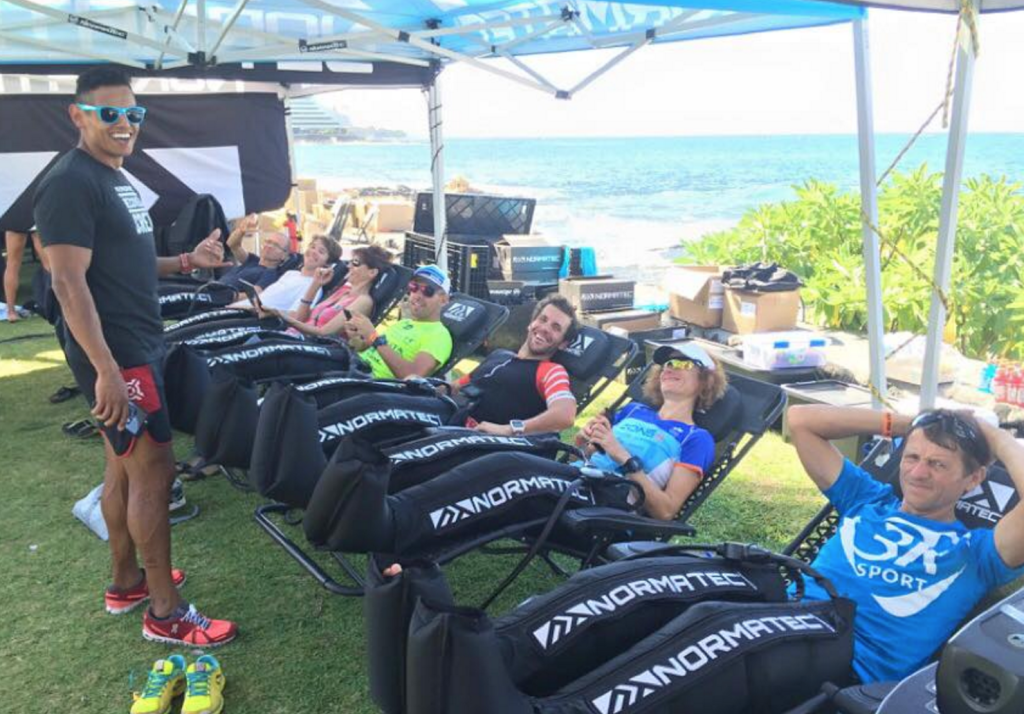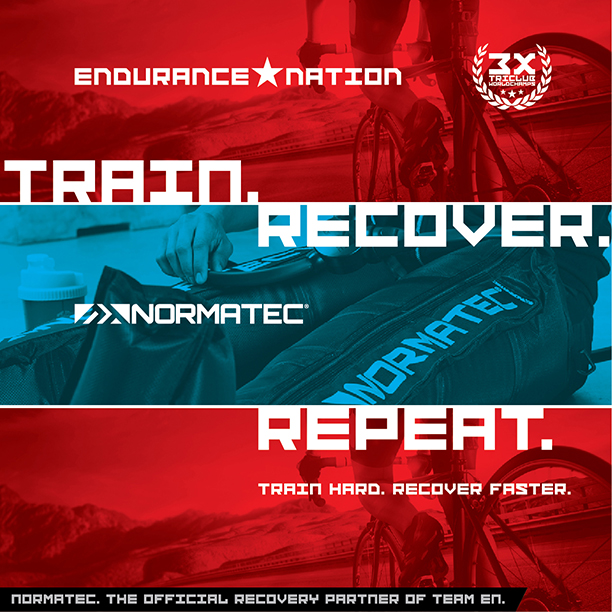
Recovery Doesn’t Get Better than This!!!! Team Normatec in Hawaii.
One of the biggest challenges that endurance athletes face every year has many different names: burnout, fatigue, meltdown, breakdown, etc. Call it what you want, the challenge remains the same. A successful season is defined as your ability to maintain or slightly increase your training load over time. But what if your mind and body are fighting you? There is simply no way that you will arrive on race day in the peak condition you need to be your best.
Failure to complete a full year of training is not a sign of weakness – it’s simply a sign of poor planning.
The fastest athletes you know are usually the smartest. Not everyone is book smart, but these high performers know their bodies and as well as their limits. While everybody knows that they need a rest day after a massive six hour bike ride, not everyone realizes the recovery period required at the end of a full season. Your biggest race of the season is essentially your biggest workout of the year. The bigger the workout – the more rest that is required. But it’s not just rest for rest’s sake — there are many other elements to this period of the year that really make it so critical to the rest of your year.
Recharging Mentally and Emotionally
Athletes also often underestimate the mental and emotional expense or cost of their season. Not only for themselves, but for other people who support them; whether, at home, socially, or the office. Taking a break is an important step in recharging your body, but also the rest of your life. You do not have to be one dimensional to be successful as an endurance athlete.
Fit But Not Freakin’ Out
It is also great just to pick up other activities that you enjoy doing or that you think you might enjoy doing. This can range from activities you might do with your family or friends, to simply something you enjoy doing that you put off for a long time. As a Type A personality, use this break as an opportunity to throw yourself into whatever that new activity might be. For me, this means getting back too tons of reading. I struggle in season with my reading simply because I fall asleep too quickly when I sit still. You might find other activities that you enjoy doing and I encourage you to embrace them.
Defining Your Action Steps
There are a few key things that you do not want to do during this rest. During this time, the last thing you want to do is to pick up a new form of strenuous exercise. Sure, it’s tempting now that you’re super fit and you feel invincible after a great year, but jumping from a full season of triathlon into something like a marathon or taking up CrossFit is not the best step for your next season.
#1 – Established Downtime
The most important part about this segment of your year is that even a small investment in your recovery can have large downstream effects. For most athletes I recommend a two week period at the end of the season where they do zero exercise. By “exercise” I mean scheduled workouts that involve tracking data, breaking a massive sweat, getting exhausted, or some combination of the three.
You can be active, you go for hikes, you can ride your bike around the neighborhood with your kids or friends and take it easy. But really commit to these two weeks. After those initial two weeks you can begin a slight return/ramping up to exercise.
I generally think of this timeframe as lasting anywhere from two to four weeks as you start to feel good again about your fitness.
#2 – Capturing Lessons Learned
One of the most important reasons to recover is that it gives you a chance to lift your head up and evaluate how you’ve done.
This is what makes the end of the season one of my favorite times of year. Reviewing what you’ve learned and accomplished is both a powerful and rewarding exercise. The next step is then to set new goals for the following season based on what you were able to achieve this season.
We do this now because this is a very difficult exercise to do when you are in the midst of your training. Most end season goal setting activities are significantly influenced by your current training, performance, and ability levels. In other words, the proximity of those other elements can significantly reduce your ability to make smart long-term decisions regarding your training and performance.
#3 – Big Goals, Small Steps
It’s no surprise that my most favorite time of year is the one revolving around setting goals. I am a very internally driven athlete. I don’t need external praise or recognition to stay focused or to strive for new heights. I do, however, take external assistance when it comes to establishing appropriate targets for the new year.
Getting input from others has two distinct benefits. First, it eliminates my personal bias of including or excluding elements of a year. Second, it’s the first step in a process towards keeping me more accountable to these goals. Simply by asking for your help with this process, I have subconsciously recruited you to help me accountable.
When I think of setting goals, I encourage people to think big. Super big. It’s really important to have goals that both inspire you and also instill you with a little bit of fear. If it’s not a stretch for you, it’s not a goal…it’s just a milestone.
Once you come up with anywhere from one to three such goals, you can then move towards to finding the incremental training milestones you need to hit along the way. For example, if you want to be able to run 80 miles in one week, then you have to be able to run at least 60 miles.
In order to get to 60 miles in a week, you’ll need several weeks in the mid-40s. And in order to get to the 40s in a good place, and to stay healthy throughout the year, you’ll need 6 to 8 weeks of very aerobic steady running. Each of these elements acts as a stepping stone for milestone that you will accomplish in route to your larger “stretch” goal. This makes it much easier to track your progress and to stay focused on doing the right work – the work that will help you achieve that bigger goal.
#4 – Starting Slowly
The final piece of the puzzle here is making sure that you give your body time to transition back into your active lifestyle. Downtime, even just two weeks of downtime, can fundamentally alter your flexibility and range of motion.
Most athletes need to balance the time off with the total amount of reentry time. If you took two weeks off, it will take you two weeks to get back to feeling normal. If you took a month off it will take that long to come back. Know this and plan for it at the outset.
The worst thing you can do is kick off the new season of training aiming for targets that you confirmed at the peak of your fitness last year. You might be the same person but you are currently not the same athlete.
In general we recommend that you plan on approximately six weeks consistent exercise before you will once again expect to feel like your old “athletic” self. Literally find your first day of training then go six weeks ahead and mark that final date with a big red X on your calendar Do everything you need to do in this early-stage to make sure that you successfully navigate the path towards Day 42, when you can return to being your “usual” athletic self.
Good luck!
Want to Recover Faster? Better? More Efficiently?
Normatec Recovery is the Official Recovery Partner of Endurance Nation training camps- visit Endurance Nation Camps Page for more information. When you register for a Long Course Training Camp, Volume Camp, Cycling Camp or the Kona Race Experience Camp, you will receive instant discounts on Normatec Recovery Boots and even enjoy boots at the camps for you to get the most out of your camp experience.


Leave a Reply